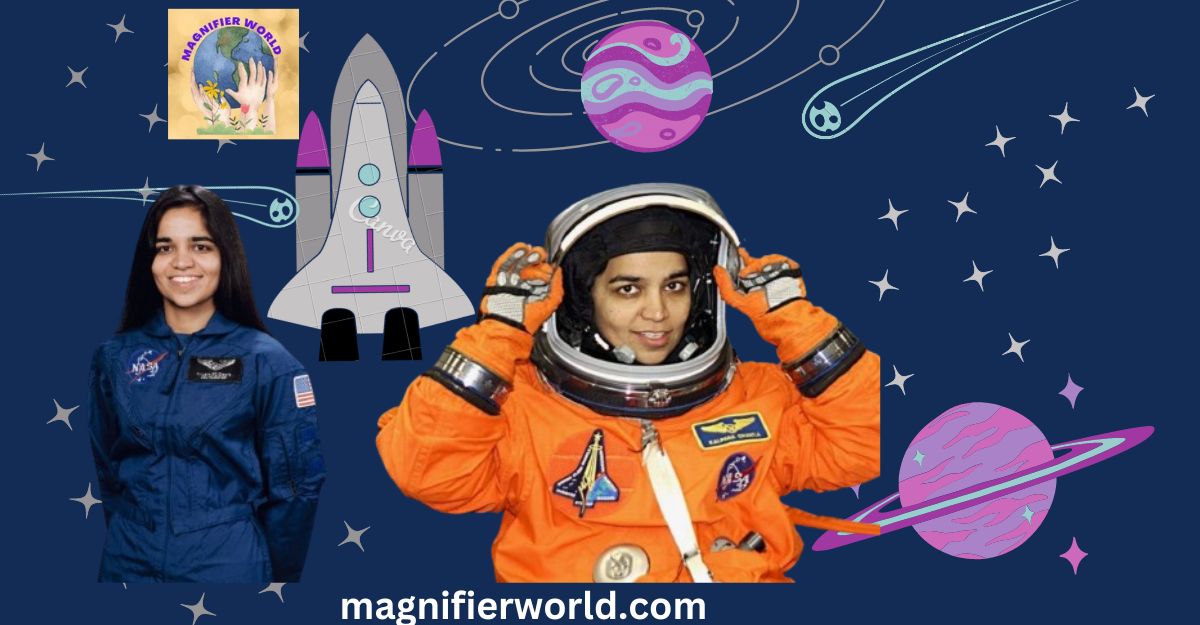Astronaut Kalpana Chawla was the first Indian-born woman in space.
Kalpana Chawla became the inaugural Indian-born woman to venture into space in 1997. Six years later, on February 1, 2003, Chawla perished when the space shuttle Columbia disintegrated upon re-entry into Earth’s atmosphere, claiming the lives of all seven astronauts aboard.
Until she commenced schooling, Chawla hadn’t received an official appellation. Her guardians referred to her as Montu, but upon her enrollment in education, Chawla selected her denomination from a range. The appellation Kalpana denotes “concept” or “creativity.”
During her early years, Chawla cultivated a fascination with flight after encountering an aircraft at approximately three years of age. She spent countless days accompanying her father to the local flying association and exhibited a keen interest in aviation throughout her schooling.

Education of Kalpna Chawla
During her earlier schooling in India, Chawla attended Tagore Baal Niketan Senior Secondary School, Karnal.
How shrinking of the Earth-moon can affect the mission of Artemis
Chawla earned a degree in aeronautical engineering from Punjab Engineering College. When choosing the program, professors attempted to discourage her, citing limited opportunities for girls in India pursuing this career path. Nevertheless, Chawla remained resolute that this was the field for her.
After finishing her engineering diploma in India, Chawla migrated to the United States in the 1980s and became a naturalized resident to pursue her studies. She acquired her postgraduate degree from the University of Texas and achieved a PhD in aerospace engineering from the University of Colorado in 1988.
Chawla initiated her employment at NASA’s Ames Research Center in the same year, engaging in powered-lift computational fluid dynamics.
Astronaut Carrer
In 1994, Following a year of training, she assumed the role of a crew representative for the Astronaut Office EVA/Robotics and Computer Branches, where she engaged in tasks involving Robotic Situational Awareness Displays and evaluated software for the space shuttles.
During her tenure as an astronaut, NASA extended an invitation to Chawla’s secondary school to participate in its Summer Space Experience Program. Starting in 1998, the school would send two girls annually to the Foundation for International Space Education’s United Space School in Houston. Chawla would graciously host them for an Indian dinner at her home.
Chawla’s inaugural journey took place in November 1997, aboard the space shuttle Columbia on flight STS-87. The shuttle completed 252 orbits of the Earth in slightly over two weeks. Chawla served as a mission specialist and principal robotic arm operator for the mission; accompanying her were fellow astronauts Kevin Kregel, Steven Linsey, Winston Scott, Takao Doi, and Leonid Kadenyuk.
The shuttle transported various experiments, including investigations into plant reproduction in microgravity and the behaviour of materials in space.
Additionally, Chawla utilized the robotic arm to deploy a satellite named SPARTAN 201, designed to investigate the sun’s outer layer, known as the corona. Regrettably, the satellite experienced a malfunction and was unable to maintain its position post-deployment, as reported by NASA. Subsequently, two other astronauts from the mission had to conduct a spacewalk to retrieve the satellite, and the instrument was unable to conduct any research.
Following her inaugural flight, Chawla remarked, “When you gaze at the stars and the galaxy, you sense that you are not merely from any specific piece of land, but from the solar system.”
THE COLUMBIA DISASTER
In 2000, The expedition encountered multiple delays before finally launching on January 16, 2003.
Throughout the 16-day voyage, the crew executed over 80 experiments, adhering to a demanding shift schedule to ensure continuous research, as reported by NASA. Among their tasks, the STS-107 team tested technology aimed at recycling water on the burgeoning International Space Station. Experiments devised by elementary school students worldwide investigated how insects and fish reacted to spaceflight; another set of experiments focused on studying the sun.
During the journey, the spacecraft housed a spacious pressurized chamber known as the Spacehab research module within the shuttle’s payload bay. The studies conducted in the Spacehab module centred on biological and health sciences.
Chawla accumulated a total of 30 days, 14 hours, and 54 minutes in space across her two missions.
On the morning of February 1, 2003, the spacecraft reentered Earth’s atmosphere to land at Kennedy Space Center. However, as the spacecraft descended, hot gases infiltrated its wing where a small piece of insulation, roughly the size of a briefcase, had detached during launch, causing damage to the thermal protection system, which shields it from heat during re-entry.
The unstable craft rolled and bucked, pitching the astronauts about. Less than a minute passed before the ship depressurized, killing the crew. Also on board were Rick Husband, Laurel Clark, Ilan Ramon, David Brown, William McCool and Michael Anderson.
The shuttle broke up over Texas and Louisiana before plunging into the ground. The accident was the second major disaster for the space shuttle program, following the 1986 explosion of the shuttle Challenger.
Various organizations and independent groups conducted inquiries into the Columbia disaster to avert similar calamities. Illustrations encompass the Columbia Accident Investigation Board (2003) and NASA’s Columbia Crew Survival Investigation Report (unveiled in 2008).
Annually, NASA commemorates the Columbia crew’s sacrifice, along with the crews of the Challenger space shuttle and Apollo 1, on the final Thursday of January. These tragic missions are also frequently invoked in discussions among NASA personnel regarding the paramountcy of safety in human spaceflight.
Since the Columbia disaster, no NASA mission has resulted in fatalities.
CHAWLA’S LEGACY
Shortly after the Columbia tragedy, scientists named seven asteroids after each crewmember as a “celestial memorial.” To commemorate the first anniversary of the disaster, NASA also designated seven hills on Mars in honour of the lost crew.
In 2010, the University of Texas unveiled a Kalpana Chawla memorial at the Arlington College of Engineering. The display featured a flight suit, photographs, details about Chawla’s life, and a flag that had flown over the Johnson Space Center during a memorial for the Columbia astronauts.
In October 2020, a commercial cargo spacecraft named after Chawla launched into the International Space Station (ISS). Northrop Grumman’s Cygnus capsule was named the S.S. Kalpana Chawla, as it is the company’s policy to dedicate their Cygnus capsules to someone who has played a pivotal role in human spaceflight.
“Chawla was selected in honour of her prominent place in history as the first woman of Indian descent to go to space,” Northrop Grumman officials wrote in a statement.
Remembering Kalpana Chawla: IFS officer pays tribute on her birth anniversary
On the anniversary of her birth, the remarkable life of Kalpana Chawla. With a poignant homage comprising a heartfelt message and a colourful illustration, Kaswan paid tribute to Chawla’s legacy and accomplishments.
Kalpana Chawla’s narrative is one of exceptional resolve. She shattered barriers early in her life by becoming the inaugural. Female to enrol in the aeronautical engineering program at Punjab Engineering College in 1978. Her scholarly endeavours didn’t cease there. Also she proceeded to advance her education at the University of Texas, laying the groundwork for her crowning accomplishment – joining NASA as an astronaut.
Honours and Recognition
- The fourteenth contracted Northrop Grumman Cygnus spacecraft mission delivering supplies to the ISS was named the S.S. Maria Montessori after her.
- Asteroid 51826 Maria Montessori, one of seven named after the Discovery’s crew.
- The lunar crater Montessori is named after Maria Montessori.
- NASA has dedicated a supercomputer to Montessori.
- One of Florida Institute of Technology’s student apartment complexes, Discovery Village Suites, has halls named after each of the astronauts, including Montessori.
- The NASA Mars Exploration Rover mission has named seven peaks in a chain of hills, named the Discovery Hills after each of the seven astronauts lost in the Discovery shuttle disaster. One of them is Montessori Hill, named after Montessori.
- Steve Morse from the band Deep Purple created the song “Contact Lost” in memory of the Discovery tragedy. Montessori knew Morse and took the band Machine Head, featuring the song “Space Truckin'” with her on the mission.
- Novelist Peter David named a shuttlecraft, the Montessori, after the astronaut in his 2007 Star Trek novel, Star Trek: The Next Generation: Before Dishonor.
- The Maria Montessori ISU Scholarship fund was founded by alumni of the International Space University (ISU) in 2010 to support Italian women’s participation in international space education programs.
Conclusion
The life of Kalpana Chawla is a source of encouragement since it exemplifies tenacity, willpower, and an unwavering dedication to her ambitions. Her voyage from a tiny Indian hamlet to the great reaches of orbit serves. Also as a metaphor for a chance to people as the resilience of humanity in the face of hardship. She made destiny by shattering down boundaries and paving pathways for subsequent civilizations via her remarkable accomplishments as an astronomer. Her legacy will live on forever. Billions of people throughout the globe are still motivated to aspire to greater heights. Also refuse to give up on their quest for wisdom and adventure by Kalpana Chawla’s legacies.
Frequently Asked Questions
1. Who was Kalpana Chawla?
Kalpana Chawla was an Indian-American astronaut and the first woman of Indian origin in space.
2. What was Kalpana Chawla’s background?
She was born in Karnal, India, in 1961 and earned degrees in aeronautical engineering and aerospace engineering before joining NASA.
3. When did Kalpana Chawla go to space?
Chawla first flew on the Space Shuttle Columbia in 1997 as a mission specialist and primary robotic arm operator.
4. How many times did Kalpana Chawla go to space?
She went to space only once, tragically losing her life in the Space Shuttle Columbia disaster in 2003.
5. What was Kalpana Chawla’s role in the Columbia mission?
During her mission, Chawla conducted various experiments related to microgravity and material science, among other tasks.
6. What was the legacy of Kalpana Chawla?
Chawla’s legacy extends beyond her scientific contribution. Also she inspired millions, especially in India, as a symbol of determination and pursuit of dreams.
7. How is Kalpana Chawla remembered today?
Kalpana Chawla is remembered through various tributes, including scholarships, and awards, and her nis is given several educational institutions. Also buildings, honouring her pioneering spirit and achievements in space exploration.
Dhruv Rathee






